Updated February 17, 2023 to ensure product accessibility accuracy.
Make a mark, erase it? Can you? Is it permanent? Will it remain with stubborn pride? Will it all wipe away except for a stain that tells of its past? Will it disappear as if it had never been there? Was it ever there? Will it smudge and spread like a tumultuous rumor imbuing itself into everything it comes in contact with? Will it be blown away in particles by a breeze from a space between the floor boards? Will it hold in some areas and crawl away from the surface in others? Will it rip apart and destroy the surface as you use it? Mark it, stroke it, smear it, smudge it, hatch it, blend it, stipple it and scribble it. Any way it is applied, artists are often compelled to incorporate drawing into their paintings. Painting, even in the most expressive manners, can feel so planned out and calculated in comparison to charcoal in the hand to the surface. Drawing has an immediacy and nostalgia that few other mediums have. Drawing speaks to our human nature and our desire to communicate and express, it is the visual outcome of what our minds tell our muscles. The use of drawing material allows an artist a mark unattainable and separate from that made with a brush.
If you happen to work in a manner in which your supply cabinet is your palette you have most likely encountered unexpected interactions between materials, some being pleasant discoveries others being less than ideal solutions. Acrylics can offer a stable support on which a wide variety of drawing media can be applied although some acrylics can be more accepting than others. We prepared a variety of acrylic surfaces and applied numerous drawing media to those surfaces to evaluate how the media held to the surface. Once we saw how the acrylics accepted the drawing media we altered the marks made to see how they reacted to manipulation.

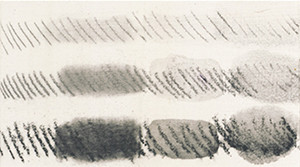
What we found was that the vast majority of drawing media could be used over a number of acrylic surfaces. The majority of marks we made held to the surface. We found that measuring the acrylic surfaces in terms of hardness and tooth was a telltale sign of how media would work upon it. Whether hard or soft, acrylics with tooth appear to provide a good adhesive surface for most if not all the drawing media we tested (Fig. 1a, 1b). An acrylic film that possesses a combination of hardness and tooth provides a surface that on much closer inspection, resembles a micro landscape of jagged rocks. As something is dragged or pushed over that surface much of that material would be snagged and remain on that rough terrain.
The drawing media could be grouped based on a number of different criteria: hardness and softness, the base or pigment, the vehicle or lack thereof or how it responded to the paper. It presents itself as being most logical to group the drawing media on its hardness and softness followed by its vehicle. Utilizing grouping by the vehicle or its solvent is only applicable if the vehicle/solvent is presumed to be the catalyst when manipulated. The charcoal (vine and compressed) and the sanguine pencil made up the first group. The second group was the 5H, 2B and 9B graphite pencils and the Conté® crayons and wax crayon, the third. The fourth group was the oil crayons and oil pastels, while the fifth group was made up of the water based or water soluble colored pencils, chalk pastels and pastel pencils. The sixth group contained all the wet media, including markers and inks.

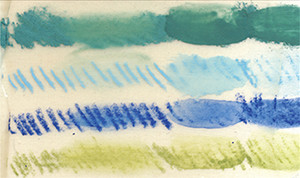
The textures of the hard and toothy surfaces range from Fiber Paste to Fine Pumice Gel. Fiber Paste (Fig. 2a), which resembles handmade paper when drawn upon, will exhibit a broken line due to a rough texture as opposed to a continuous line achieved with Fine Pumice Gel (Fig. 2b). The thicker and softer films have a greater susceptibility to damage from harder media. For example, Light Molding Paste and Crackle Paste, which both lend themselves to thicker application, will provide a fine, soft surface for vine charcoals and dry pastels but media like graphite and Conté® crayons will etch the acrylic surface without imparting any actual media.
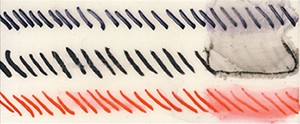

Smoother and glossier acrylic surfaces held wetter media better than that of dry (Fig. 3). Markers, inks and oil based media were applied easier but manipulation of that mark sometimes proved to be a fugitive marriage. The glossy and hard surfaces accepted most media applied to it but when rubbed or wetted much of the media could be removed. The surface was too slick to provide adhesion. It did however, support the hardest of the graphite pencils, which etched and marred many of the softer acrylic films. The texture of hard, glossy surfaces sometimes provided a unique tooth that allowed for interesting manipulation with the wetter and softer media. An example of surfaces like this would be Glass Bead Gel or Clear Granular Gel which seems to simultaneously provide a non-porous surface with a toothy texture, which held media within the crevasses of the film but allowed the glossy tops of the glass bead and granules to be wiped clean (Fig. 4). Glossy and soft surfaces provided enough tack to have slightly better adhesion than a glossy hard surface.
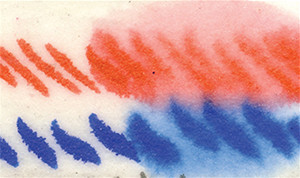
When looking at the media used for drawing, the possibilities are almost endless. We chose to look at some of the more common options that artists may use. We tested vine and compressed charcoal, 5H, 2B and 9B graphite pencils, Conté® crayons, sanguine pencil, wax crayon, pastel pencil, water soluble oil pastels, water soluble colored pencils, dry pastels, oil pastels, markers, and inks. Each was applied in a series of short strokes over 24 acrylic surfaces. The nature of how each behaved when applied and adhered to the acrylic surface was noted. Each piece of drawing media was applied in a series of small strokes to each of the 24 acrylic surfaces and then manipulated by rubbing, washing with water or washing with alcohol. The initial drawn marks were observed for how they lay on the surface, how they responded to the texture of the acrylic and how they held to that surface. The rubbed area served two main purposes: to see if the media could be removed by mechanical rubbing or if it would adhere and how it responded to blending or smudging? Did it blend seamlessly? Did it leave a trace of the mark made? Or, did it not do anything? The area washed with water showed how the media reacted to water, how it dispersed, and how the wet media was accepted to the acrylic surface. The area washed with alcohol showed the solubility of the media and how it reacted with the acrylic surface, how it dispersed and if it changed the nature of the media (Fig. 5).
We applied the drawing media to 24 different acrylic surfaces. Those surfaces can be roughly grouped into six different categories based on their characteristics. The first is a group of grounds, which are surfaces that are typically absorbent and toothy and formulated to accept a wide variety of materials. The next group is acrylic paint in which we chose Fluid Acrylics as well as SoFlat Matte Acrylics. The third group included liquid mediums that dry glossy with a fair degree of hardness to their finish. The fourth group consisted of very matte and toothy surfaces. The fifth group was made up of soft and flexible films and the final group was the pastes, which tended to offer the largest range of textures and surfaces, hardness and softness but all contained opacity and a fair amount of porosity and tooth.
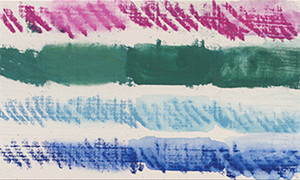
The GOLDEN Acrylic Grounds used for this testing were Gesso, Sandable Hard Gesso, Absorbent Ground, Silverpoint / Drawing Ground, and a mixture of one-third Gesso, one-third Light Molding Paste and one-third Hard Molding Paste (synthetic chalk ground). These grounds accepted all of the drawing media applied to them with no adverse results. The more porous grounds provided better blending. Absorbent Ground, being the most absorbent without too much flexibility, allowed for not only a well received mark by all media but also permitted the media to be easily manipulated (Fig. 6). The drier and more friable media, like charcoal and pastels, were able to be blended and smudged evenly and maintained adhesion to the Absorbent Ground. The sponge-like absorbency without the flexibility afforded by the Absorbent Ground allowed for the water and alcohol to disperse some of the marks into a wash without entirely obliterating the original mark. In the case of the waterproof inks, the alcohol was the most effective in creating a wash, as the water left the mark unaffected.
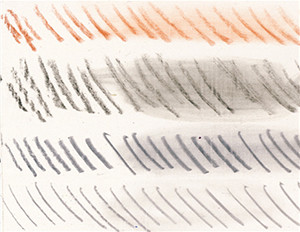

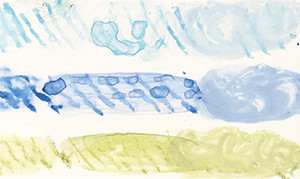
The Gesso, Sandable Hard Gesso and synthetic chalk ground reacted similarly with only slight variations to one another. The Sandable Hard Gesso was wet sanded to a burnished finish before the media was applied. The harder, less porous surface allowed for sharper and crisper drawn lines (Fig. 7). When those drawn lines were blended, the product was less likely to produce a soft edge and had a better chance of removing the original mark. Being an absorbent and spongy surface, the synthetic chalk ground accepted more of the media than the other two, leaving a softer and wider mark. Blending the media on synthetic chalk ground left a very soft and well blended area, especially with softer media such as charcoal and pastel (Fig. 8). When the media was scrubbed with water and alcohol on the three surfaces, Sandable Hard Gesso had the least amount of bleed to the area around the application, while the synthetic chalk ground had the most. In the case of these mixtures, the harder the surface, the more responsive it was to harder media. The softer the surface, the more likely it was to be etched by hard media, such as the graphite pencils. The Silverpoint / Drawing Ground in all cases similarly accepted drawing media in comparison to Gesso. When scrubbed with alcohol, Silverpoint / Drawing Ground had an inclination to resolubilize small amounts of Titanium White within the ground, resulting in a tint of the drawing media used (Fig. 9). Other than this anomaly, the Silverpoint / Drawing Ground was one of the best receptive surfaces for drawing media.

The next group contained products not commonly thought of as grounds, including GOLDEN Heavy Body and Fluid Acrylics. These paints allow each individual pigment to retain its natural sheen. The glossier paints are less likely to hold drawing media in the same manner that the matte paints do. The Matte Heavy Body and Matte Fluid Acrylics, formulated for a more matte surface, allow for good adhesion throughout, regardless of the natural sheen of the pigment (Fig. 10). The glossier of the paints were less likely to receive the softer and more friable drawing media such as charcoal, pastel and sanguine charcoal pencil, thus making them more easily removed in both blending and wetting with either the water or alcohol. So, regarding the results for drawing media over paints, we see that they all accept the drawing media, although they are more fragile on glossier surfaces and may need to be protected.

The third group consisted of harder, glossier and less porous surfaces. We included Polymer Medium and GAC 200 in this group. Polymer Medium is softer and more flexible than GAC 200 and although both accepted the media, neither facilitated blending with the harder media (Fig. 11). The Polymer Medium did not accept the wax crayon and very little of the graphite pencil, while the GAC 200 accepted most. The wet media faired well on these surfaces, although the marks seemed to wash away easily with isopropyl alcohol.

Matte surfaces are the best candidates for an adhesive drawing surface. The matting solids contained in these polymers helps contribute to a toothy surface that will physically hold the drawing media and allow for more controlled blending and greater permanence due to greater adhesion. All of the matte surfaces tested in this group have a different level of translucency. While none are clear, Matte Medium, Fluid Matte Medium and Acrylic Ground for Pastels offer a considerable amount of transparency and can be used in addition to or on top of the colors if drawing media is to be applied. Fluid Matte Medium did not hold graphite and wax crayon very well and what did remain on the surface was easily wiped away. Acrylic Ground for Pastels functioned beautifully in application as well as in manipulation, followed by the Fine Pumice Gel and Super Loaded Matte Medium (Fig. 12).

The fifth group, made up of softer and more flexible gels, has the least tendency to hold drawing media. The acrylics used for this group were Regular Gel (Gloss), Regular Gel (Semi-Gloss), Regular Gel (Matte) and Glass Bead Gel. As with the fourth group, Regular Gel (Matte) provided the best drawing surface of these four gels although because of its flexibility, the harder media such as the graphite pencils, did not adhere well (Fig. 13). Regular Gel (Gloss and Semi-Gloss) exhibited poor adhesion with several of the drawing mediums.
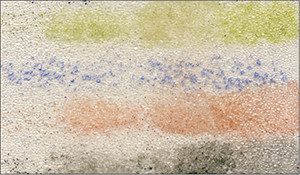
Glass Bead Gel acted like no other surface and each different media delivered varied results. The glossiness of the gel and the non-porous nature of the glass beads seemed to resist any media while the texture allowed it to hold on to friable/ dry, and wet media although would not exhibit any mark from the graphite pencils until blended. When the media was blended over Glass Bead Gel, the color or pigment would remain in the grooves of the film while the tallest points of the beads could be wiped clean providing an interesting result (Fig. 14). With the gels, removal by blending was very possible, especially with the glossier varieties. Wet media did best on these surfaces, although manipulation was either unachievable or resulted in complete removal.

The final group was made up of a wide variety of textured pastes. The pastes are opaque and each has its own unique texture, degree of hardness and porosity. The softer and spongier surfaces, such as Light Molding Paste and Crackle Paste accepted the softer and more friable media as well as the markers and water soluble oil pastels but harder media such as graphite pencils, wax crayons and Conté® crayons etched the surface, holding no trace of the drawing implement applied (Fig. 15). Fiber Paste with its handmade paper texture did not hold the crisp line delivered by the graphite pencil but did allow for soft blending of what was drawn (Fig. 16). The top most points of the texture held most of the media, emphasizing the bumpy texture even more when drawn upon.

The Molding Pastes: Light, Regular, Hard and Coarse all provided good adhesion for the media. The Light and Regular Molding Pastes allowed for controlled and even blending while the Coarse Molding Paste surface allowed for very diffused and softer blended edges. Hard Molding Paste did not facilitate blending as well as the other Molding Pastes and retained much of the original drawn mark. Scrubbing the Molding Pastes with water and isopropyl alcohol did allow for even blending except with the Hard Molding Paste, in which the water beaded up in some areas and completely removed the product in others. This again showed that harder and less porous surfaces had less adhesion when scrubbed with water or solvent.
In conclusion there are a vast amount of outcomes one can achieve depending on what you want to draw with, what you want to draw on and the desired results. The ease of using acrylics in order to create a suitable drawing surface onto paintings, sculptures or any surface an acrylic film can be applied to, allows an artist to expand their language of communication that is not always afforded by utilizing the substrate or available surface alone. To some artists, the use of drawing to express immediacy, intimacy and identity is imperative – as essential to the work as is the permanency and archival nature of the materials used and methods used to apply those materials. As with any material or method that is not clearly documented, experimentation and testing can provide better results, less surprises and amazing discoveries. Understanding the nature of the materials you are using is a valuable tool that is more often than not instinctual. Not knowing is an opportunity to learn and grow and understand your materials beyond what you thought or could anticipate.
Supporting Imagery:
About Amy McKinnon
View all posts by Amy McKinnon -->Subscribe
Subscribe to the newsletter today!
No related Post

